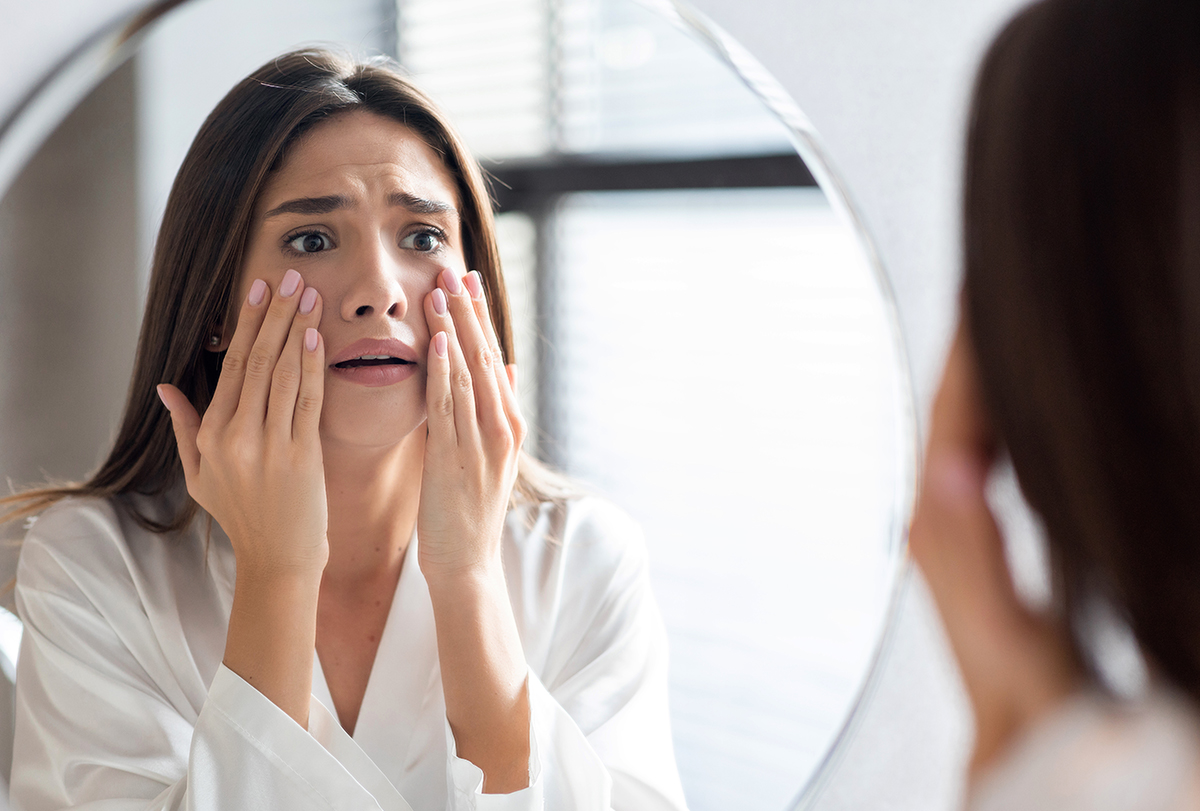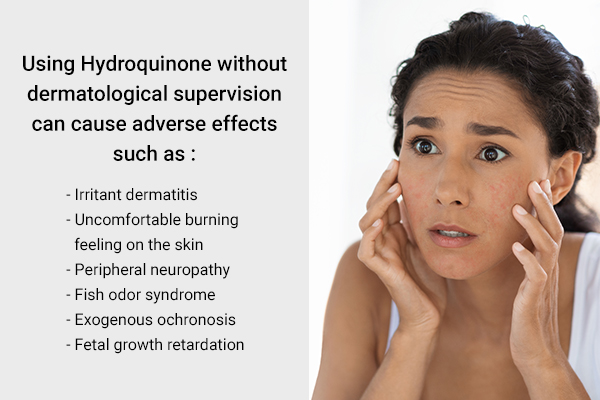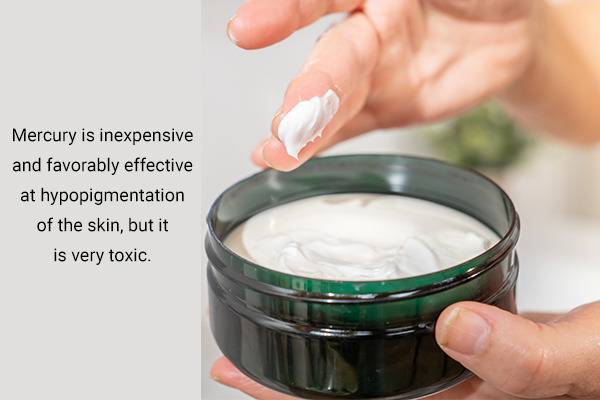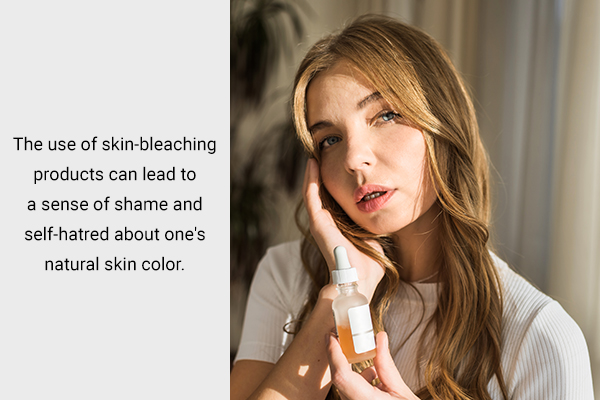In this article:
Skin bleaching, or skin lightening, is the practice of intentionally lightening the skin’s color using different products and methods. It is done by reducing the production of melanin, which gives the skin its color.

A recent study found that around 27.7% of people worldwide engage in skin bleaching. It is more common among people who are living in cities, have lower education levels, and are over 55 years old. It is also prevalent in Asian, African, and Caribbean countries. (1)
It’s important to note that skin-lightening treatments can be dangerous. They can lead to serious side effects and complications, as warned by various experts.
Why Is Skin Lightening Dangerous?
There are a variety of methods used for skin lightening, ranging from professional treatments to over-the-counter creams and prescription medications.
These products often contain chemicals such as hydroquinone, super potent topical steroids, or mercury, which can have harmful and long-term effects on the skin and overall health, and their misuse has been associated with several serious and irreversible complications.
The unsupervised use of skin-bleaching or skin-lightening agents can indeed pose a significant public health risk as these drugs can cause serious local and systemic complications due to their side effects and other health risks.
Furthermore, skin lightening is a controversial topic, as it has been associated with cultural and societal issues, such as colorism and discrimination.
So, these products can also have serious negative effects on mental health, as their use is often motivated by societal and cultural pressures to conform to certain beauty standards and can contribute to low self-esteem and other psychological issues. (1)
Read on to take a better look at the different available skin-lightening treatments and their safety.
Skin-Lightening Agents and Associated Dangers
Skin-lightening agents come with potential dangers and associated risks.
1. Hydroquinone

Hydroquinone (HQ), also known as 1,4-dihydroxybenzene, is a synthetic compound that has been used as a skin-lightening product for decades. When used without dermatological supervision, it can cause adverse effects such as: (2)
- Irritant dermatitis – skin irritation and inflammation
- Uncomfortable burning feeling on the skin
- Peripheral neuropathy – nerve damage affecting the extremities
- Fish odor syndrome – unpleasant body odor resembling that of fish
- Exogenous ochronosis – a rare skin condition causing darkening and discoloration
- Fetal growth retardation – impaired fetal development
Note: The specific concentration of skin-lightening agents that can cause fetal growth retardation is not clearly defined. It is crucial to avoid using high concentrations of skin-lightening agents during pregnancy to ensure the safety of the unborn child.
It is advisable to consult with a healthcare professional for personalized guidance on product usage during pregnancy.
2. Topical corticosteroids
Topical corticosteroids (clobetasol, betamethasone, and flucinolone) are linked with a group of cutaneous and systemic adverse effects when used without medical supervision and particularly in the context of skin bleaching. These effects include: (1)(2)(3)
- Telangiectasia formation – red spider veins
- Steroid-induced acne – acne from steroids
- Perioral dermatitis – rash around the mouth
- Purpura – purple discoloration
- Hypertrichosis – excessive hair growth
- Dyspigmentation – abnormal skin color
- Photosensitivity – increased sensitivity to sunlight
- Poor wound healing and striae – delayed healing and stretch marks
- Cutaneous infections – skin infections
Note: Systemic side effects of topical steroids can affect the whole body and may include problems such as adrenal suppression (which affects hormone production), Cushing syndrome (which causes weight gain and other changes), high blood pressure (hypertension), and suppression of the body’s natural hormone system (hypothalamic-pituitary-adrenal axis). These effects can have various impacts on your overall health and well-being.
3. Mercury

Mercury is inexpensive and favorably effective at hypopigmentation of the skin, but it is very toxic and can cause adverse events including – (2)(4)
- Gingivitis – gum inflammation
- Gastrointestinal upset – stomach discomfort
- Palmoplantar skin peeling – peeling of the skin on the palms and soles
- Nail dyspigmentation – discoloration of the nails
- Neuropsychiatric complications – mental and emotional issues
- Paresthesia – abnormal sensation
- Muscle weakness – loss of strength
- Visual field disturbance – vision problems
- Auditory disturbance – hearing problems
- Nephrotoxicity – kidney damage
- Fetal anomalies – birth defects in babies
Note: The Minamata Convention on Mercury is a global treaty designed to protect human health and the environment from the adverse effects of mercury. One of its provisions sets an upper limit of 1 mg/kg (1 ppm) for the presence of mercury in skin-lightening products. However, in countries where the use of mercury in cosmetics is not banned, these products may still contain high levels of mercury, which can pose a significant health risk to users. (1)
Complications of Laser Skin Lightening
Laser skin-whitening therapy is a cosmetic procedure that uses lasers to reduce the melanin content in the skin, thereby lightening the skin tone. However, like any medical procedure, laser skin-whitening therapy is associated with potential risks and complications.
One of the most common complications of laser skin-whitening therapy is burns or scarring. This can occur if the laser is not used correctly or if the skin is not properly prepared before the treatment.
Dyspigmentation is another potential side effect of laser skin-whitening therapy, which can result in uneven skin coloration and blotchiness.
In addition to these potential skin-related complications, laser skin-whitening therapy can also result in ocular injury, which can occur if the laser is directed too close to the eyes. Infection is also a potential risk. (5)
Note: It is important for individuals considering laser skin-whitening therapy to be aware of these potential risks and to discuss them with a qualified and experienced medical professional.
It is also important to choose a reputable provider who uses safe and effective techniques and to follow all pre- and post-treatment instructions carefully to minimize the risk of complications.
Emotional Complications of Skin Lightening

Research has shown that skin bleaching can have negative psychological effects on individuals. The use of skin-bleaching products can lead to a sense of shame and self-hatred about one’s natural skin color. This can be particularly true in societies where lighter skin is associated with a higher social status or beauty standards.
This sense of shame and self-hatred can lead to increasing dissatisfaction with one’s skin tone, which can create a vicious cycle of skin bleaching followed by persistent dissatisfaction. This cycle can ultimately lead to a poor self-image and low self-esteem. (1)(6)
Why Do People Perform Skin Lightening Despite the Danger?
The desire to lighten the skin is a complex and multifactorial issue. It is often driven by a range of social, cultural, and historical factors that have contributed to the formation of certain beauty standards and ideals.
Colorism
One important factor is colorism, which is a form of discrimination based on skin color. Colorism refers to the preference for lighter skin tones and the discrimination against individuals with darker skin tones within the same ethnic or racial group.
Colorism is a pervasive and persistent issue that is rooted in colonialism, where European colonizers imposed their standards of beauty and social hierarchy on the populations they colonized.
This has led to the creation of a complex set of beliefs and practices around skin color, including the idea that lighter skin is associated with a higher status and beauty.
Media coverage
Media has played a significant role in perpetuating beauty standards and ideals. Advertisements, films, and TV shows often promote images of lighter-skinned people as more desirable and attractive, leading to a reinforcement of colorism.
It is important to acknowledge the social and cultural factors that drive the desire to lighten the skin and work toward dismantling these harmful and discriminatory beliefs.
Promoting diversity and inclusivity in media and advertising and education and awareness-raising campaigns are just a few ways people can do to achieve a more accepting and equitable society. (7)(8)(9)
Skin Lightening Under Medical Supervision

It is important for individuals to use skin-bleaching or skin-lightening agents only under the supervision of a healthcare professional or licensed dermatologist, who can monitor their use and advise on safe and effective methods of achieving their desired skin tone.
It is also important to promote diversity and inclusive beauty standards that celebrate and embrace the natural beauty and uniqueness of all skin tones.
What Is the Safest Skin Lightening Agent?
It is always best to embrace and appreciate your natural skin tone.
However, the safest approach to skin lightening is to use topical products that contain ingredients such as vitamin C, niacinamide, and kojic acid, which are known to help brighten the skin without causing damage.
Additionally, experts suggest incorporating sun-protection measures, such as wearing sunscreen and avoiding excessive sun exposure, to prevent further skin darkening and damage.
It’s important to avoid harsh bleaching agents or unregulated products that may contain harmful ingredients, as they can cause adverse effects on the skin.
Most-Asked Questions About Skin Lightening
Does turmeric help lighten the skin?
Anecdotal evidence and expert opinions deem turmeric to be helpful in brightening the skin.
Is skin lightening permanent?
Some skin-lightening treatments may provide temporary results, requiring continuous or periodic use to maintain the desired effect. Other treatments, such as laser therapy or certain chemical peels, may offer longer-lasting results.
Is skin lightening possible naturally?
When it comes to natural skin lightening, it is possible to achieve subtle lightening effects through some natural ingredients or remedies. For example, using ingredients such as lemon juice, turmeric, and yogurt may help to lighten the skin to some extent.
Final Word
It is important to be aware of the potential risks associated with skin-lightening products and to only use products that have been tested and certified as safe.
It is also crucial to read the labels of cosmetics and skin care products carefully, to look for any ingredients that may be harmful or potentially toxic, and to avoid using any products that contain mercury or other dangerous substances.
- Was this article helpful?
- YES, THANKS!NOT REALLY


